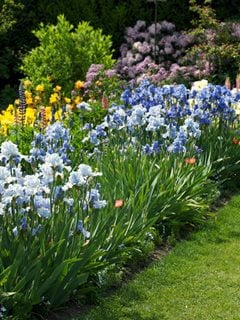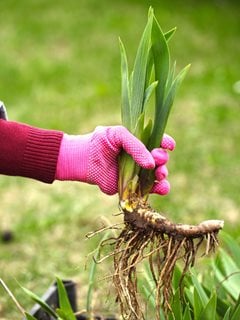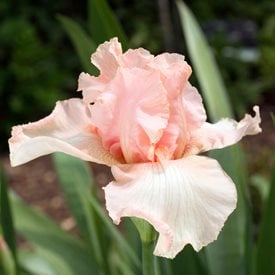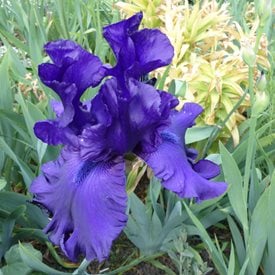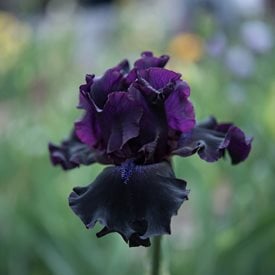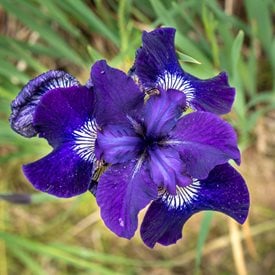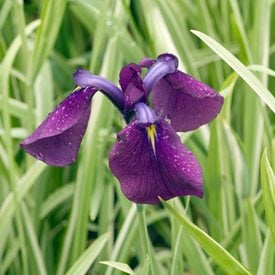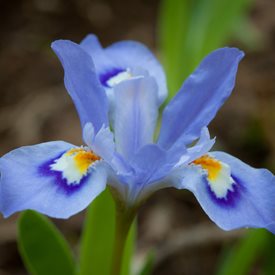Grow Irises for Easy Elegance in Your Garden
Irises are easy-to-grow perennial plants with elegant, colorful flowersWith many different types and colors available, there is an iris for nearly every garden. Named after the Greek goddess of the rainbow, irises bring color to the garden in spring and summer. The vast majority are hybrids with the most popular being bearded irises. Other popular varieties include Siberian and Japanese irises, Louisiana irises which are native to North America, and Dutch hybrids.
On this page: Basics | Types of Irises | Planting Irises | Care | Iris Pictures | Design Tips
IRIS BASICS
Zones:
Varieties suitable for zones 3-9
Height/Spread:
Irises come in many different sizes, some as short as six inches and others can grow up to four feet.
- Dwarf varieties 6 to 12 inches tall and wide
- Dutch varieties 1-1/2 to 2 feet tall and 6 to 12 inches wide
- Tall bearded varieties range from 2 to 4 feet tall and 1-1/2 to 2 feet wide
Exposure:
Irises need full sun at least half the day. Some varieties will tolerate part shade such as Siberian irises and Pacific Coast natives (Iris innominata, Iris tenax, Iris macrosiphon and Iris douglasiana). Many irises will grow in total shade, but they most likely won't flower.
Bloom Time:
The majority of irises will bloom in spring or summer. Dwarf varieties tend to bloom earlier in spring, with intermediate sizes blooming later spring, and taller bearded varieties blooming late spring and summer. Reblooming varieties will produce flowers once in summer and again in fall.
Color:
There is an extremely wide variety of colors, ranging from white to almost black; although most common in shades of lavender, purple, white and yellow.
Toxicity:
Iris are known to be toxic to pets, with the bulb being the most toxic part. See more Common Poisonous Plants for Dogs and Cats.
TYPES OF IRISES
There are 2 main groups of irises: rhizomatous and bulbous. The bulbous irises bloom in late spring, while the rhizomatous irises bloom during summer.
Rhizomatous irises:
Grown from rhizomes (a type of bulb) and can be further divided into 3 categories:
- Bearded: Bearded irises are the most widely grown and get their name from the prominent ‘beard’ of white or colored hairs in the center of each fall (outer surrounding petals). Many varieties will produce multiple flowers per stem and are available in a wide range of colors.
- Beardless: Beardless irises include the Siberian, Japanese, Pacific Coast and Louisiana types, and all have smooth falls. Siberian irises are known to be highly adaptable and a good choice for low maintenance mixed borders. Japanese and Louisiana varieties are better suited for moist to wet soils, while the Pacific Coast varieties are best in milder climates with winter rain and drier summers.
- Crested: Crested irises do well in full sun or partial shade areas in moist, humus-rich soil.
Bulbous irises:
This group includes the Dutch hybrids and the smaller reticulated or dwarf irises. They all shed their leaves after the blooming season and go into a dormant phase over summer. Dutch hybrids tend to bloom earlier than the tall bearded rhizomatous varieties and are the well-known variety featured in florist’s spring bouquets. Reticulated irises are well-suited for growing in groups, but should be divided every two to three years to prevent overcrowding. They are also good for rock gardens and forcing in pots.
PLANTING IRISES
When to plant:
The best time to plant iris rhizomes or bulbs is late summer to early autumn to allow them plenty of time to establish roots before the growing season ends. In hotter climates, they can be planted in September or October.
Where to plant:
Choose a sunny location for your irises where they won’t be subject to standing water. Raised beds are ideal for growing irises, as they provide the good drainage needed.
How to plant:
Prepare the planting beds up to two weeks ahead by loosening soil to a depth of 10-12 inches to establish good drainage. At this time, organic matter can also be mixed in. Iris rhizomes should be planted so that they are slightly visible on the soil surface, or thinly covered in warmer climates. They can be top dressed with a low-nitrogen fertilizer (avoid high-nitrogen as it can cause rot). Make 2 rows in the soil with a small ridge in between. Place the rhizome on the ridge and spread the roots to either side. Steve Schreiner, of Schreiner’s Iris Gardens in Oregon, says, “There are two reasons irises don’t bloom: planted too deep or not enough sun.” Iris bulbs, such as Dutch irises, should be planted at a depth of 5 inches, pointed end up and roots down, spacing them at 6 bulbs per square foot.
Soil:
Most irises prefer average to fertile, neutral to slightly acidic, well-drained soil. However, Japanese irises prefer lime-free soil.
For more on planting bulbs see Bulbs 101: Planting and Storing Bulbs
IRIS CARE
Maintenance:
Cut back the flowering stalks after flowering, but leave the foliage intact so it can continue to gather and store nutrients and energy to be stored for the following season. Trim leaves off at ground level after they turn yellow in fall; this will reduce the possibility of overwintering diseases or pests.
Dividing Iris Rhizomes:
Rhizomatous types need to be divided every 3-5 years, typically soon after bloom time. A reduction in blooming or rhizomes being pushed up out of the soil can be signs that it’s time to dig them up and divide. If this is a dividing year, don’t cut the foliage back - so you know where they are. Dig the rhizomes up carefully and divide them by pulling apart with your hands. Some, however, may need to be cut with a knife. Healthy rhizomes will be approximately ¾ to 1-inch in diameter, with a good root structure and one to two leaf fans. Older or unhealthy (soft, rotting, or hollow) rhizomes should be discarded. Wash the roots with water and inspect for disease or pests, especially iris borer worms. Trim the leaves to 4 to 6 inches and re-plant as above, with the rhizome on a ridge and roots fanned out. Water newly planted irises well.
Amendments & Fertilizer:
Apply a low-nitrogen fertilizer a month before bloom time. Mulch should not be used on top of rhizomes or near the foliage as it can cause rot. For reblooming varieties, apply a light application of fertilizer following the first bloom and water regularly during summer dry periods for an improved second bloom in fall.
Watering:
Irises generally have low water requirements once established, but can use a little extra if unusually dry just before bloom time. Louisiana, Siberian and Japanese irises need more water than the bearded types.
Propagation:
Although irises can be started from seed, it may be a couple of years before they bloom. Most often, they are propagated by division of the bulbs or rhizomes in late summer or early fall.
Diseases and Pests:
Irises can be severely damaged by iris borers and thrips if not controlled. Whiteflies, slugs and snails, aphids and nematodes may also be a nuisance. Deer will seldom harm irises, but may occasionally bite off the blossoms of the crested types, although will usually spit them out and leave them behind. Irises may also be affected by bacterial leaf blight, rhizome rot, leaf spot, rust, and viruses.
Other:
All parts of irises may cause severe discomfort if ingested. Gloves should be worn when handling iris plants, rhizomes, or bulbs, as the sap can cause skin irritation.
IRIS PICTURES
DESIGNING WITH IRISES
With the diversity of colors and sizes available, there is an iris suitable for every area of the garden:
- Iris blossoms make spectacular additions to perennial borders.
- Plant taller varieties with shrubs or in the back of perennial borders and lower- to medium-growing varieties mid-border.
- Irises provide beautiful contrast with ornamental sages and peonies, but keep the irises from being crowded by neighbors.
- Siberian and Japanese irises remain attractive all summer and make graceful additions to poolside plantings.
- Mix several varieties for blooming early spring through fall.
- Irises make excellent cut flowers and are best cut when the topmost flower is just beginning to open. Vase longevity is affected by temperature, with a maximum vase life of about one week.
- To keep multi-flowered irises looking pretty, they can be trimmed from the top down as flowers open and fade.
- Plant irises where you can watch and enjoy the butterflies and hummingbirds they will attract.
- Good drought-tolerant companions are: daylily, coneflower, lavender, sedum, blanket flower, black-eyed Susan and phlox.
Shop for iris plants on Amazon
Last updated: September 12, 2018
RELATED:
20 Best Summer Bulbs to Grow
Top 20 Spring-Blooming Bulbs
Roses
Lilies
